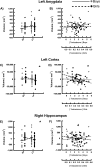Puberty influences medial temporal lobe and cortical gray matter maturation differently in boys than girls matched for sexual maturity
- PMID: 20713504
- PMCID: PMC3041011
- DOI: 10.1093/cercor/bhq137
Puberty influences medial temporal lobe and cortical gray matter maturation differently in boys than girls matched for sexual maturity
Abstract
Sex differences in age- and puberty-related maturation of human brain structure have been observed in typically developing age-matched boys and girls. Because girls mature 1-2 years earlier than boys, the present study aimed at assessing sex differences in brain structure by studying 80 adolescent boys and girls matched on sexual maturity, rather than age. We evaluated pubertal influences on medial temporal lobe (MTL), thalamic, caudate, and cortical gray matter volumes utilizing structural magnetic resonance imaging and 2 measures of pubertal status: physical sexual maturity and circulating testosterone. As predicted, significant interactions between sex and the effect of puberty were observed in regions with high sex steroid hormone receptor densities; sex differences in the right hippocampus, bilateral amygdala, and cortical gray matter were greater in more sexually mature adolescents. Within sex, we found larger volumes in MTL structures in more sexually mature boys, whereas smaller volumes were observed in more sexually mature girls. Our results demonstrate puberty-related maturation of the hippocampus, amygdala, and cortical gray matter that is not confounded by age, and is different for girls and boys, which may contribute to differences in social and cognitive development during adolescence, and lasting sexual dimorphisms in the adult brain.
Figures




References
-
- Angold A, Costello EJ, Erkanli A, Worthman CM. Pubertal changes in hormone levels and depression in girls. Psychol Med. 1999;29:1043–1053. - PubMed
-
- Archer J. Rodent sex differences in emotional and related behavior. Behav Biol. 1975;14:451–479. - PubMed
-
- Arnold AP. Sex chromosomes and brain gender. Nat Rev Neurosci. 2004;5:701–708. - PubMed
Publication types
MeSH terms
Grants and funding
LinkOut - more resources
Full Text Sources
Medical
Research Materials

